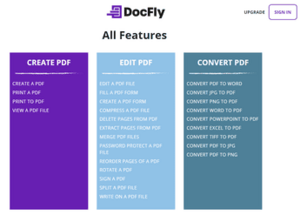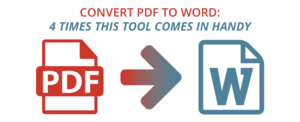Why You Should Use & Create Fillable PDF Forms

Reasons to create PDF forms Historically, transforming paper-based form and intake processes to an online system was both expensive and difficult. Thankfully, the PDF File format is so easy-to-use that it has come to help many ordinary organizations upgrade their systems without the need for a taxing conversion process. Beyond the global trend towards going digital, here are three good reasons to choose the PDF file form specifically: Easy to create While in the past organizations often had to purchase expensive desktop PDF software or rely on a separate service in order to create fillable PDF forms, this is no...
Common errors you might see in PDF to Word conversion

Scenarios for converting PDF to Word If you are handed a large paper file that needs to be reviewed and edited, scanning the file and converting it from PDF to Word is the most practical way to create an editable file. If your team is about to email a PDF proposal to a client and you catch a last minute typo, quickly convert it to Word, make the necessary changes, review it, convert it back from Word to PDF and send it off to the client. If you’re a book publisher who receives manuscripts in all sorts of formats, you...
A Brief History of Microsoft Word

Hiring the best talent Gates and Allen set out to hire the best programmers they could find. In 1981, their search led them to Charles Simonyi and Richard Brodie, two Xerox Bravo programmers who were instrumental in building Xerox's original word processing programme. Simonyi and Brodie worked tirelessly -- aiming to develop the world's best word processing tool to date. In 1983, Microsoft launched Word 1.0 in "What You See Is What You Get" (WYSIWYG) mode for Xenix and MS-DOS. Word 1.0 could run in graphics and text mode, but bold, italics, and underline features were only available in the...
PDF Compression: 5 things you probably didn’t know

1. What PDF stands for Adobe asked people in the business district of Salt Lake City what the acronym “PDF” abbreviates. Although everyone responded that they were familiar with PDFs, only 8% actually knew what “PDF” stood for. Do you? a. Portable Data File b. Portable Document Format c. Process Document Form d. Pretty Darn Fast If you selected “b. Portable Document Format,” congratulations -- you beat out 92% of survey participants. Compressed PDFs have become an integral part of our daily communications and filing systems. Yet, few people actually know what the acronym stands for, or the origins of...
Finding the Best PDF Editor - Features You've Definitely Gotta Have

First, do I really need a PDF editor? Admittedly, as creators of a PDF editor and longtime fans of one of the world's most popular file formats, we're biased - but yes, you should have a PDF editing tool you can count on. Here are a few benefits of using PDF: PDFs save paper and time. Instead of printing, completing, scanning and resending an online form or document, a great PDF editor skips a whole bunch of those steps. Just add text to the form using an editor, save it, and send it. No printer? No problem! If you don't...
Convert PDF to Word: 4 Times This Tool Comes in Handy

When to Convert PDF to Word So when would someone need to convert a PDF to Word? Turns out that’s a tricky question to answer. Below are five potential situations when it may be handy to have access to a PDF to Word converter. 1.) Old file Maybe you got a new computer or accidentally deleted an old document, and for whatever reason you only have access to the PDF version of a file. Then converting the PDF to Word can allow you to go back and make edits without having to retype the entire document. In this...
History of PDF: Creating the World's Most Popular File Format

PDF files were created to retain formatting PDF, or Portable Document Format, was the first file format of its kind to store and share text and images in a manner that would preserve the formatting of the original document. Regardless of which software, hardware or platform it is being viewed on. For example, if the original document was created on a Mac, it could easily be sent via email to a colleague using Windows, and they'd be able to see the exact same visual. And vice versa. Today's online tools can convert almost any file format to a PDF - whether...
The pros and cons of converting a PDF to Word

Converting a PDF to Word can be a practical solution for many individuals and businesses, offering various advantages and disadvantages. Users in both camps will usually find a wide range of online and desktop software-based solutions that can meet their needs. As I’ve discussed earlier, there are pros of cons of heading down either route. Online solutions tend to be much cheaper (and often free), but may not fully meet a user’s needs given the limitations of browser-based technologies. There are also issues regarding privacy and data protection that make many business users uncomfortable with online solutions. On the other...
3 ways converting a JPG to PDF can protect your images

1. Prove the image has not been changed If your concerns are limited to the recipient making changes, then you only need to convert your JPG to PDF. Upon converting your JPG, sign your PDF, and this ensures that the document cannot be modified. The risk of an unsigned PDF is that someone may be able to edit the metadata (which is not secured), thereby concealing any edits. This issue is fixed by applying an electronic signature to your document. If changes are made to a signed PDF, they will show up in the PDF reader. Note that while software...
How did the PDF become so popular?

John Warnock’s vision for the future The initial technology came about as a side project operated inside Adobe by John Warnock, one of the company’s founders. His vision was to provide the technology that would ultimately enable the paperless office. In The Camelot Project, a paper outlining Warnock’s vision, he wrote: ‘Imagine being able to send full text and graphics documents (newspapers, magazine articles, technical manuals etc.) over electronic mail distribution networks. These documents could be viewed on any machine and any selected document could be printed locally. This capability would truly change the way information is managed.’ The initial...